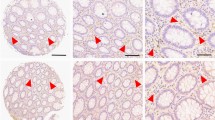Abstract
Methionine adenosyltransferase (MAT) catalyzes the synthesis of S-adenosylmethionine (AdoMet) from ATP and l-methionine. AdoMet is the major methyl donor in most transmethylation reactions in vivo, and it is also the propylamino donor in the biosynthesis of polyamines. In the present study, we assessed MAT activity in human colons with colorectal carcinoma and the values were compared with those of morphologically normal adjacent mucosa. Higher levels of MAT activity were observed in the colorectal carcinoma than in the normal colon. The ratio of MAT activity in tumor tissue versus normal tissue seemed to be correlated well will the stage of the colorectal tumor. Furthermore, immunoblot analysis showed that the high levels of MAT activity observed in colorectal carcinoma were due to the increased amounts of MAT protein. Immunohistochemical analysis revealed that MAT was most abundant in goblet cells, particularly in granules in the supranuclear area of these cells. In the colorectal carcinoma tissues, MAT was strongly stained in the cancerous cells and localized in granules in the supranuclear region. The results of this preliminary study suggest that determination of the relative ratio of MAT activity in both normal and tumor regions in human colorectal carcinoma could be a clinically useful tool for determining the stage of malignancy of colorectal carcinomas.
Similar content being viewed by others
References
Cantoni GL (1953) S-Adenosylmethionine; a new intermediate formed enzymatically froml-methionine and ATP. J Biol Chem 204:403–416
Okada G, Teraoka H, Tsukada K (1981) Multiple species of mammalian S-adenosylmethionine synthetase. Partial purification and characterization. Biochemistry 20:934–940
Horikawa S, Sasuga J, Shimizu K, Ozasa H, Tsukada K (1990) Molecular cloning and nucleotide sequence of cDNA encoding the rat kidneyS-adenosylmethionine synthetase. J Biol Chem 265:13683–1368
Cabrero C, Puerta J, Alemany S (1987) Purification and comparison of two forms of S-adenosyl-l-methionine synthetase from rat liver. Eur J Biochem 170:299–304.
Kunz GL, Hoffman JL, Chai CS, Stremel B (1980) Separation of rat liver methionine adenosyltransferase isozymes by hydrophobic chromatography. Arch Biochem Biophys 202:565–572
Kotb M, Kredich NM (1985) S-Adenosylmethionine synthetase from human lymphocytes: purification and characterization. J Biol Chem 260:3923–3930
Akerman K, Karkola K, Kajander O (1991) Methionine adenosyltransferase activity in cultured cells and in human tissues. Biochim Biophys Acta 1097:140–144
Tobena R, Horikawa S, Calvo V, Alemany S (1996) Inteleukin-2 induces γ-S-adenosylmethionine synthetase gene expression during T-lymphocyte activation. Biochem J 319:929–933
De La Rosa J, Geller AM, LeGros H, Kotb M (1992) Induction of interleukin 2 production but not methionine adenosyltransferase activity or S-adenosylmethionine turnover in Jurkat T-cells. Cancer Res 52:3361–3366
De La Rosa J, LeGros HL, Geller AM, Kotb M (1992) Changes in the relative amount of subunits of methionine adenosyltransferase in human lymphocytes upon stimulation with a polyclonal T cell mitogen. J Biol Chem 267:10699–10704
Horikawa S, Kobayashi Y, Sugiyama T, Terashima H, Wada K, Tsukada K (1993) Expression of non-hepatic-type Sadenosylmethionine synthetase isozyme in rat hepatomas induced by 3′-methyl-4-dimethylaminoazobenzene. FEBS Lett 334:69–71
Dukes CD (1932) The classification of cancer of the rectum. J Pathol Bacteriol 35:323–331
Mitsui K, Teraoka H, Tsukada K (1988) Complete purification and immunochemical analysis of S-adenosylmethionine synthetase from bovine brain. J Biol Chem 263:11211–11216
Laemmli UK (1970) Cleavage of structural proteins during the assembly of the head bacteriophage T4. Nature 227:680–685
Astler VB, Coller FA (1954) The prognostic significance of direct extension of carcinoma of the colon and rectum. Ann Surg 139:846–852
Horikawa S, Tsukada K (1992) Molecular cloning and developmental expression of a human kidneyS-adenosylmethionine synthetase. FEBS Lett 312:37–41
Horikawa S, Ozasa H, Ota K, Tsukadas K (1993) Immunohistochemical analysis of rat S-adenosylmethionine synthetase isozymes in developmental liver. FEBS Lett 330:307–311
Shimizu KS, Horikawa S, Kojima N, Shiga J, Senoo H, Tsukada K (1997) Differential expression of S-adenosylmethionine synthetase isozymes in different cell types of rat liver. Hepatology 26:424–431
Author information
Authors and Affiliations
Rights and permissions
About this article
Cite this article
Ito, K., Ikeda, S., Kojima, N. et al. Correlation between the expression of methionine adenosyltransferase and the stages of human colorectal carcinoma. Surg Today 30, 706–710 (2000). https://doi.org/10.1007/s005950070081
Received:
Accepted:
Issue Date:
DOI: https://doi.org/10.1007/s005950070081




